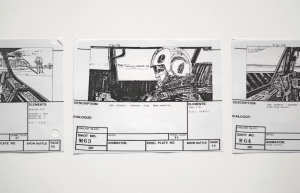In the world of visual storytelling, one of the most crucial tools at a creator’s disposal is the storyboard.
A well-crafted storyboard serves as the blueprint for films, animations, commercials, and even interactive media. It’s a visual representation of the narrative, helping creators plan out scenes, shots, and sequences before the actual production begins.
In this comprehensive guide, we’ll delve into the art of how to create a storyboard, exploring their significance, the process of crafting them, and tips to ensure their effectiveness.
The Significance of Storyboards
Storyboards act as a bridge between imagination and execution. They allow creators to visualize their ideas, ensuring that everyone involved in the project, from directors to animators, shares a unified vision. Here’s why storyboards are so significant:
- Visualizing the Narrative: Storyboards help translate the written script into a visual format. This visualization is crucial in understanding how scenes will flow, how shots will be framed, and how the narrative will unfold.
- Effective Communication: Storyboards facilitate effective communication among the creative team. They provide a clear reference point for discussing concepts, shot compositions, and visual style.
- Time and Cost Efficiency: By planning out each shot in advance, storyboards reduce the risk of expensive re-shoots or revisions during production. This efficiency can save both time and money.
- Creative Exploration: Storyboards encourage creative exploration. Creators can experiment with different angles, compositions, and pacing to find the most engaging way to present the story.
- Collaboration: Whether it’s a small team or a large crew, storyboards ensure that everyone is on the same page, working toward a common goal.
Crafting a Storyboard
Creating a compelling storyboard involves a structured process that requires careful consideration of various elements. Let’s explore the steps to crafting an effective storyboard:
- Understand the Script: Before diving into the visual representation, thoroughly understand the script. Identify key scenes, pivotal moments, and character interactions that need to be captured visually.
- Break Down the Narrative: Divide the script into scenes and further break down each scene into shots. Each shot represents a distinct visual perspective, helping to narrate the story coherently.
- Sketching and Composition: Begin by sketching rough thumbnail drawings for each shot. Focus on composition, framing, and camera angles. These sketches don’t need to be detailed; the goal is to capture the essence of the scene.
- Sequence and Flow: Arrange the sketches in sequential order to create a visual flow that mirrors the narrative’s progression. This step allows you to identify any gaps or inconsistencies in the story’s pacing.
- Add Descriptions and Notes: Accompany each sketch with descriptions and notes. These annotations provide additional context, explaining camera movements, character actions, and any other relevant details.
- Iterate and Refine: Review the storyboard as a whole and refine the sketches and annotations. Ensure that the visuals align with the intended tone and mood of the story.
Tips for Crafting Effective Storyboards
Simplicity Is Key
Keep your sketches simple and focused on conveying the core elements of the scene. Cluttered visuals can detract from the storytelling.
Focus on Emotions
Capture characters’ emotions and expressions to evoke empathy from the audience. Facial expressions and body language play a pivotal role in storytelling.
Vary Shot Types
Experiment with different shot types, such as wide shots, close-ups, and over-the-shoulder shots. This variation adds visual interest and aids in conveying information.
Consider Camera Movement
Visualize how the camera will move within a shot. Whether it’s a static shot or a dynamic pan, camera movement influences the viewer’s perspective.
Color and Mood
Use shading and color to set the mood of each scene. Warm tones might evoke comfort, while cool tones could signify tension or mystery.
Storyboard Software
While avoiding direct promotion of tools, it’s worth mentioning that various software applications are available for creating digital storyboards. These tools offer advantages such as ease of revision and collaboration.
Feedback and Collaboration
Share your storyboard with colleagues and team members to gather feedback. Collaborative input can lead to improvements and a more refined final product.
Common Mistakes to Avoid in Storyboard Creation
While storyboards are invaluable tools for visual storytelling, there are some prevalent mistakes that creators should steer clear of to ensure their effectiveness:
Overcomplicating Visuals
Avoid overly detailed drawings that could lead to confusion. Keep sketches simple while capturing the scene’s essence without overwhelming details.
Lack of Clarity
Ensure your storyboard is clear and understandable to a wider audience. Avoid ambiguity in sketches and annotations, making additional explanations unnecessary.
Neglecting Pacing and Timing
Consider pacing and timing in your storyboards. Match the shot flow to the narrative’s rhythm to prevent scenes from feeling rushed or dragged.
In Conclusion
Crafting a storyboard is a meticulous yet rewarding process that forms the foundation of visual storytelling.
Storyboards enable creators to transform abstract ideas into tangible visual representations, fostering collaboration and ensuring a coherent narrative flow.
By understanding the significance of storyboards, following a structured process, and incorporating effective techniques, creators can enhance their storytelling abilities and create visually captivating experiences that resonate with audiences.
Whether it’s a film, animation, or any other visual medium, the art of storyboard creation remains an essential skill for every storyteller.

